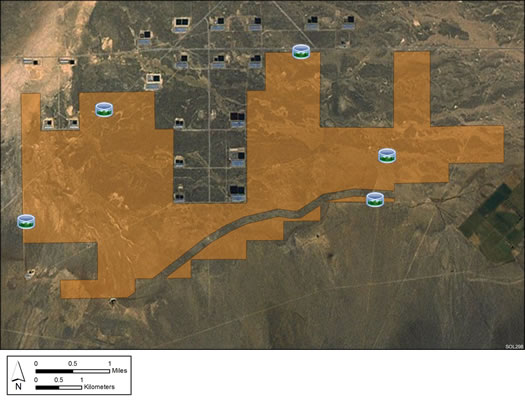| Utah Variance Areas | Milford Flats South SEZ |
 |
 |
The Milford Flats South Solar Energy Zone (SEZ) is a designated leasing area (DLA) located in Utah in the Escalante Desert. The SEZ is located on BLM-administered land within the Cedar City Field Office.
The Milford Flats South SEZ has a total area of 6,480 acres (26 km2). In the 2011 Supplement to the Draft Solar PEIS, 228 acres (0.9 km2) composing the Minersville Canal were identified as a non-development area, leaving the SEZ with a potentially developable area of 6,252 acres (25.3 km2). No additional changes to the SEZ developable area were made in the 2012 Final Solar PEIS.
The Milford Flats South SEZ is located in Beaver County in rural southwestern Utah. The SEZ is located in the northeastern section of the Escalante Desert, bounded by Mineral Mountains to the northeast, Black Mountains to the south and southeast, Shauntie Hills to the northwest, and Wah Wah Mountains to the west. In 2008, the county population was 7,265, while adjacent Iron County to the south had a population of 45,833. The largest nearby town is Cedar City about 30 mi (48 km) south-southeast. Several small towns are located closer to the SEZ.

Land within the Milford Flats South SEZ is undeveloped scrubland characteristic of a high-elevation, semiarid basin. Vegetation consists primarily of low shrubs with areas of bare soil and gravel.
A number of unpaved roads cross the SEZ. The land within the SEZ contains livestock ponds (typically dry), cattle trails, and wire fences. No electric transmission lines are located within the SEZ. Part of the SEZ is authorized by the BLM for grazing. The SEZ may be used by local residents for general outdoor recreation, including backcountry driving and off-highway vehicle use, recreational shooting, and small and big game hunting.
Numerous large buildings that are part of a commercial confined hog-rearing operation are located on private land adjacent to the northern border of the SEZ. There are irrigated farms to the east of the area.

The nearest major road to the Milford Flats South SEZ is State Route 21/130, about 5 mi (8 km) east in Minersville. A smaller spur of State Route 129 is about 3 mi (5 km) northwest of the SEZ. Access to the Milford Flats South SEZ is by county and local roads. The nearest alternating current transmission line is a 345-kV line that runs north to south about 19 mi (31 km) southeast of the eastern boundary of the SEZ.
In the 2012 Solar PEIS, the BLM committed to establishing a monitoring and adaptive management strategy for each solar energy zone (SEZ). Through these strategies, the BLM will take an active role in the collection of baseline data for the SEZs.
The BLM has not yet begun the monitoring and adaptive management strategy for the Milford Flats South SEZ. However, the BLM has conducted a pilot monitoring and adaptive management strategy for the Riverside East SEZ. In May 2016, the BLM released the Riverside East Solar Energy Zone Long Term Monitoring Strategy Final Report. The monitoring strategy document (PDF, 16.6 MB) is now available.
In the 2012 Solar PEIS, the BLM committed to preparing solar regional mitigation strategies (SRMSs) for the solar energy zones (SEZs). These regional mitigation strategies were intended to simplify and improve the mitigation process for future solar projects in SEZs.
In 2016, the BLM began development of a solar regional mitigation strategy (SRMS) for three Utah SEZs: the Escalante Valley, Milford Flats South, and Wah Wah Valley SEZs. Information on the draft Utah Solar Regional Mitigation Strategy is available on the project website, linked below.
With IM-2019-018, the BLM established policy that compensatory mitigation could not be required as a condition for project approvals. However, with the issuance of IM 2021-038 on July 14, 2021, the BLM rescinded the previous IM-2019-018. The BLM expects to establish policies which are aligned with EO 13990, SO 3398, and the priorities of the Department. During this interim period offices should consider and implement compensatory mitigation on a case-by-case basis, in consultation with state office and national office program specialists and the Office of the Solicitor as needed.
Interested parties can learn more by visiting the Utah SRMS project website at:
https://blmsolar.anl.gov/solar-peis/sez/ut/regional-mitigation/